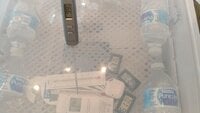Teacher1993
Hatching
- May 1, 2020
- 2
- 1
- 1
Hi everyone!
Back story first. So this was an unexpected duck egg into my life. A mallard duck laid it next to my pool and then didn't come back for it. I got an incubator for it and it was growing. On day 25, I put more water in it for a higher humidity around 75%. On day 27, I opened the lid for 5 seconds to add more water. There was a small hole in which Humidity was seeping through.
Now today is day 29. No movement, no pipping (that I know of) Humidity is now 63%. Do I add more water? Should I be concerned that this mallard duck hasn't done anything with it being day 29? What do I do? I know nothing about ducks!!! I am freaking out and I do not want make a mistake.
Thank you in advance!
Back story first. So this was an unexpected duck egg into my life. A mallard duck laid it next to my pool and then didn't come back for it. I got an incubator for it and it was growing. On day 25, I put more water in it for a higher humidity around 75%. On day 27, I opened the lid for 5 seconds to add more water. There was a small hole in which Humidity was seeping through.
Now today is day 29. No movement, no pipping (that I know of) Humidity is now 63%. Do I add more water? Should I be concerned that this mallard duck hasn't done anything with it being day 29? What do I do? I know nothing about ducks!!! I am freaking out and I do not want make a mistake.
Thank you in advance!

